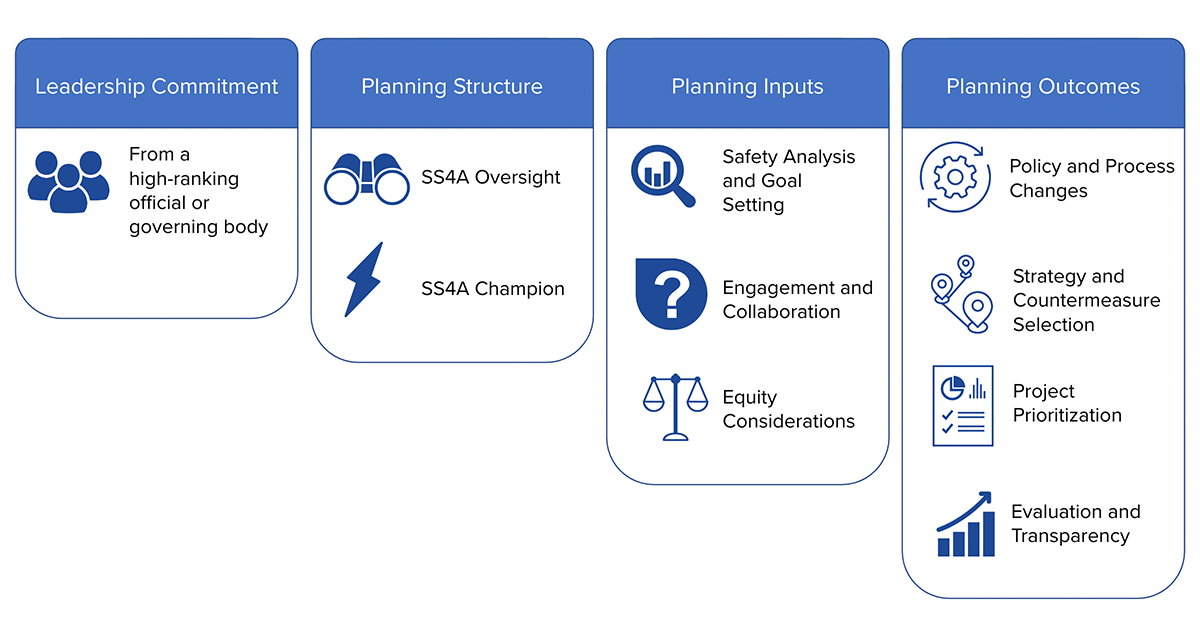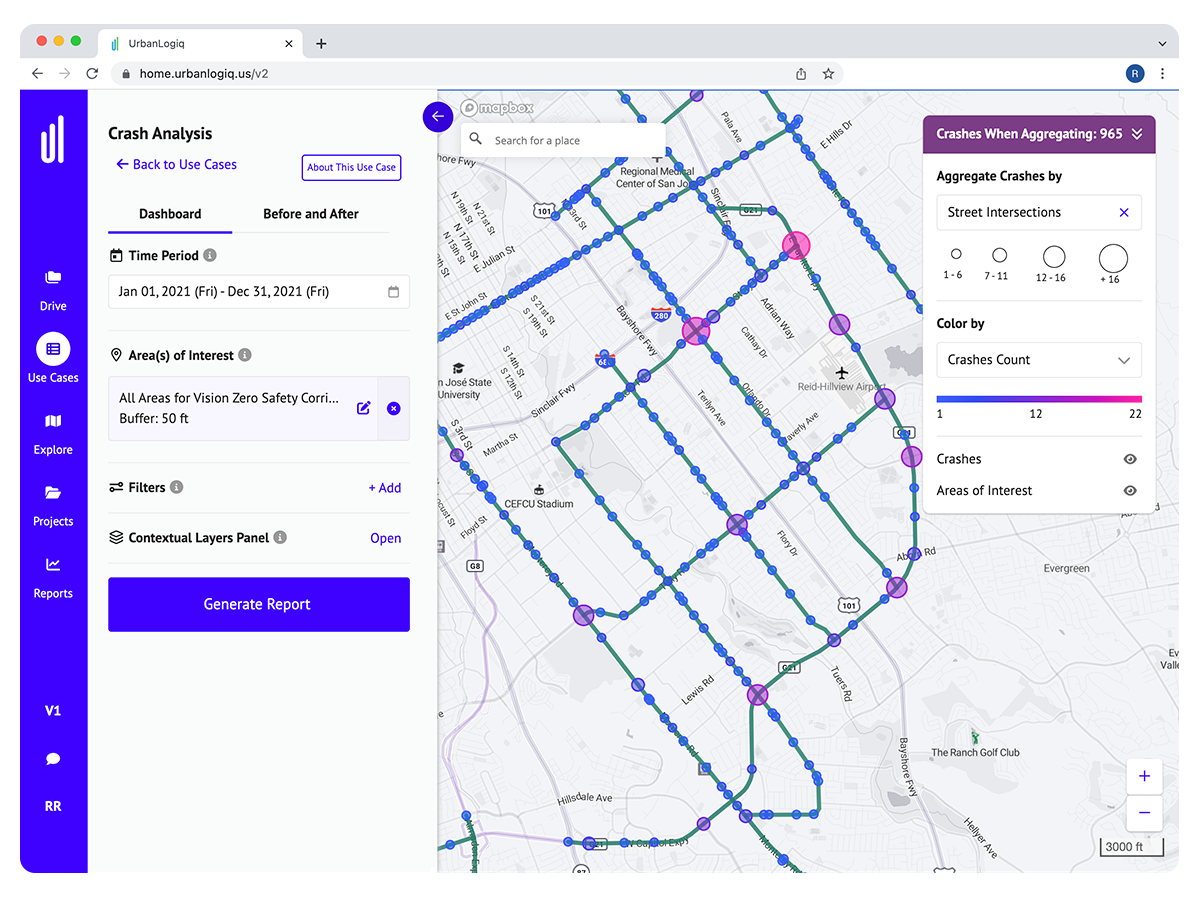3 Tips to Optimize Your Safe Streets and Roads for All (SS4A) Action Plan Application
Safe Streets and Roads for All (SS4A) dominated headlines in the road safety space when it was announced in 2022.
Established under the Bipartisan Infrastructure Law (BIL), the $5 billion SS4A discretionary grant program is a core component of the U.S. Department of Transportation’s (USDOT) strategy to reduce roadway deaths across the country. The program represents a shift to the Safe System approach, which underpins Vision Zero, and a commitment to helping communities prioritize safety.
The USDOT released several FAQs and resources for applicants, which are worth taking a look at if you are making an application.
In this blog, we discuss:
- Grant background and grant recipient eligibility
- Three tips to optimize your application
- How UrbanLogiq can help before and after the award
A brief overview of the Safe Streets and Roads for All (SS4A) program
Whether you are new to the SSFA opportunity or already working on an application, here are the key takeaways that all applicants should know:
There are two types of grants available:
- Action Plan Grants (the focus of this blog) – for agencies requiring funds to develop or complete an Action Plan, or to “conduct supplemental planning activities.”
- Implementation Grants – for agencies making tangible changes outlined in Action Plans, using a Safe System Approach.
Note: You need to have a qualifying Action Plan in place to be eligible for an Implementation Grant.
The next round for SS4A applications is expected to open in April 2023.
To get the most out of the SS4A program, applicants may make sequential applications. For example, applying for an Action Plan Grant in Year 1 or 2 followed by an Implementation Grant in Year 3 or 4 that builds on the evidence and insights acquired during the planning stage.
Key takeaway: If you’re on the fence, we think it is worth going through the exercise of completing an Action Plan Grant application – and sooner rather than later. Here’s why:
- Early adopter advantage: While $1 billion annually is a large pot of possible funding, no more than 15% of funds can be awarded to projects in a single State in a given fiscal year.
- Set up for success: Even if unsuccessful in the first round you apply, applicants who start preparing a data-driven, evidenced approach now will be better positioned for an application in the following round. This will also help applicants’ chances of securing an Implementation Grant before the end of the 5-year program.
Eligible agencies
The types of eligible agencies are fairly broad. Many applicants in the initial round were multi-jurisdictional partnerships, with the application led by metropolitan planning organizations (MPOs):
- Metropolitan planning organizations
- Counties
- Cities and towns
- Transit agencies
- Special districts (subdivisions of a State)
- Federally recognized Tribal governments
- Multi-jurisdictional groups comprised of the above entities (councils, partnerships)
Eligible activities
The focus of Safe Streets and Roads for All opportunity is for communities to take a proactive approach to road safety. Eligible activities under the program reflect this focus:
- Developing or updating a comprehensive safety action plan (Action Plan)
- Conducting activities that support an Action Plan
- Carrying out projects and strategies identified in an Action Plan (Implementation)
Safe Streets and Roads for All Action Plan components
The primary deliverable for an Action Plan Grant is a publicly available Action Plan. The plan should include the components below.

How much funding can you budget?

Key takeaway: For many applicants, the expected minimum of $200,000 for Action Plan Grants seems like a large sum. It is important to note that this is just an expectation, not a literal minimum. Applicants can request less, as shown by some of the awards in the first round. However, if your budget is significantly under the minimum, you may want to reflect on whether the core elements of your application are underdeveloped.
Three tips to optimize your Safe Streets and Roads for All application
As Federal grant processes go, the Action Plan application is relatively straightforward. The key thing is to maximize the benefit this once-in-a-generation funding opportunity brings to your organization. Here are three simple ways to enhance your proposal and align it with the SS4A evaluation criteria.
1. Collaborate and partner to improve outcomes
Collaboration and partnership are consistently referred to in the Notice of Funding Opportunity (NOFO). As underscored in the Safe System approach, there is a paradigm shift toward increasing collaboration between all safety stakeholders. Throughout the NOFO, applicants are encouraged to partner with public and private sector collaborators. This is especially relevant when considering equity, addressing climate change and adopting innovative technologies.
2. Deploy technology for a data-driven approach
The SS4A NOFO emphasizes the need to adopt innovative technologies. Tools that not only optimize data collection but help applicants gain a clearer picture of their roads. Tools that help measure the impact of safety initiatives more effectively.
When it comes to employing low-cost, high-impact strategies, applicants should consider how adopting new technology can help them improve road safety in their community. For example, is your application well under the $200,000 funding minimum? Reflect on whether you are sufficiently leveraging data, insights, and technology to improve outcomes.
3. Safety. Equity. Climate. Include all three.
A key sentiment of the program is to engage more voices and more communities. Grant evaluators will actually assess whether applicants have engaged with public and private stakeholders in order to allow for community representation and feedback. The second SS4A selection criterion is dedicated to ensuring that activities will lead to equitable investment in addressing the safety needs of underserved communities.
How UrbanLogiq can help
SS4A program funds represent an ideal opportunity for governments of all sizes to procure innovative technology to improve road safety in their communities.
Whether you are a city traffic department or an MPO taking the lead on a regional application, UrbanLogiq can help you move from a reactive approach to a proactive approach to road safety.
Integrated data and insights at your fingertips
Use UrbanLogiq’s Crash Analysis Tool to get a full picture of what is happening on your roads through spatial and predictive analysis of crashes. Identify your High Injury Network and generate fast insights like the Top 10 dangerous road segments in your region.

Crashes along Vision Zero Safety Corridors visualized in the UrbanLogiq platform
Supporting equity considerations
UrbanLogiq has helped several government clients with the identification of underserved communities through data. Furthermore, our platform enables public officials to assess both population characteristics and the initial equity impacts of proposed projects and strategies.
Helping you to measure your impact and report on your grant funding
Measure the impact of safety countermeasures and Vision Zero policies over time. UrbanLogiq’s Before and After analysis provides a measurement and reporting framework for grant outcomes such as:
- Roadway safety outcomes and any additional benefits
- Recommendations for future projects or road safety improvement strategies
- Aggregated annual crash data on serious injuries and fatalities
Learn More
Secure the funding you need to improve road safety in your community. Contact us today to discuss how we can partner on an SS4A grant opportunity.





